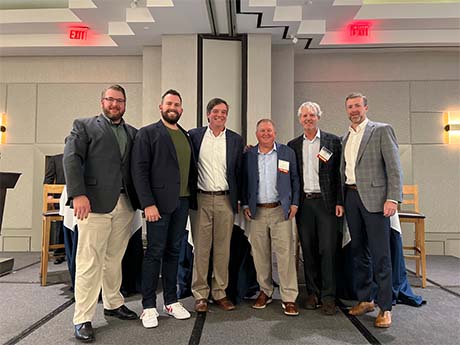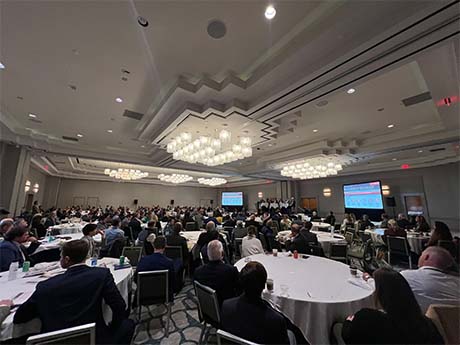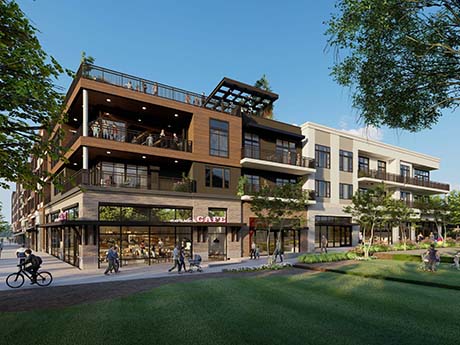ATLANTA — Multifamily developers are bracing for the uncertainty of 2024 as their projects are delivering into a landscape where new supply is outpacing demand by a significant margin. In the third quarter, a total of 114,000 new multifamily units were delivered in the United States compared to 82,100 absorbed, according to research from CBRE.
The absorption figure is technically rebounding as it represents the highest quarterly figure since early 2022, but there is still a sizeable delta compared to supply growth. The trailing four-quarter total for U.S. multifamily deliveries stands at 376,500 units, which CBRE reports is the highest since it began tracking the metric 27 years ago.
“This is historic supply,” said Todd Oglesby, managing director of Alliance Residential Co.’s Southeast division. “It’s at the highest levels since the 1980s.”

Oglesby made his comments as part of a panel of developers at France Media’s InterFace Multifamily Southeast, an annual conference held on Thursday, Nov. 30 at the Westin Buckhead hotel in Atlanta. Chad Riddle, senior project manager at Bohler, moderated the panel entitled “Given the Interest Rate & Debt Market Environment, How Are Developers Making New Projects Pencil?”
Throughout the full-day conference, several panelists mentioned that their firms’ current business strategy is “survive ‘til ‘25” in hopes that the turmoil caused by inflation and rapid interest rate increases the past few years will be resolved over the next 13 months. Alan Dean, region CEO of Terwilliger Pappas, said his company estimates an additional 12 months might be needed for supply-demand to get on solid footing.
“We’re betting on 2026,” said Dean. “I’m more worried about our deals that we started two years ago than anything else.”
Terwilliger Pappas is currently building Solis Dresden Village, a 183-unit apartment community in Brookhaven, an intown suburb of Atlanta. The company expects to deliver the property, which will be attached to 32,000 square feet of retail and restaurant space, in fall 2024.
Patrick Kassin, development partner at Woodfield Development, said that his firm has three projects underway in the Southeast and one in lease-up. The property that recently delivered is Holden at Oak Grove, a 276-unit apartment community in Athens, Georgia.
While deliveries are currently at record levels, the developers on the panel agreed that the industry will hit the brakes on new multifamily starts in 2024. Bennett Sands, managing development director at Wood Partners, said his firm will slow to seven or eight starts in 2024, compared to the 15 or 16 in 2023 and the 32 that began in 2022.
“We can’t ignore the supply wave that we’re on the front end of,” said Sands. “While fundamentals are good, it’s going to get worse before it gets better.”
Burdened by costs
The consensus from the panel is that it’s harder than ever to get deals to pencil out as they are burdened by cost increases for nearly every input — such as construction materials, land, labor and insurance. The developers opined that the headwinds they’re facing are nothing new, but they don’t have historic rent growth as a safety net like in years past.
According to CBRE, the average monthly net effective rent grew 0.7 percent year-over-year in the third quarter, which is lower than the pre-pandemic five-year average of 2.7 percent and far below the peak of 15.2 percent rent growth in first-quarter 2022.
“Rent growth offset a lot of the problems we had,” said Sands.
The panelists agreed that they’d love to develop more, but the cost structures in place currently are “out of whack” with historic norms, which is putting a cap on the returns that they can achieve. Oglesby said that of all the hurdles that are outside of their control, one tangible approach has been reducing costs. For example, Alliance Residential created its own division to purchase construction materials and circumvent a large chunk of its cost burden.
“We launched a purchasing platform that will negotiate directly with the vendor to cut out all that margin in the middle,” said Oglesby. “We also try to partner with other developers to purchase products like refrigerators in bulk. In the past 18 months, we saw costs go up almost 40 percent. And we think a lot of that was marginal — there was more work than there were people to do it.”
Another practical way that developers are reining in costs is by conducting cost analyses for the amenity packages that they’re offering. Sands said reducing the amenities at a property is an “easy way to cut $1 million from the budget.”
Oglesby said that Alliance Residential’s Prose-branded apartments, which are often built in the suburbs and markets where blue-collar job growth is occurring, are offering more basic amenities to reduce costs, which will ultimately be passed on to renters in the form of affordability.
“People need a place to live, they don’t need seven bocce ball courts,” said Oglesby. “At Prose we have the core amenities, or ‘everything you need, nothing you don’t.’ We’re not in an amenity war anymore, it’s kind of the opposite now. We’re going back to the essentials.”
Ian Hunter, regional director of Dwell Design Studio, was the lone architectural representative on the panel. He said that his firm is finding success on behalf of its clients by cutting swimming pools out of the amenity package, which he said has been historically unheard of in the Southeast.
“It’s probably the largest thing in your building, and it’s also a high dollars-per-square-foot area,” said Hunter. “It’s also a liability.”
Kassin added that, fundamentally, the properties that developers began in the past six months differ greatly from those that they broke ground on two years ago.
“If you started a project in 2021, you’re over-budget and six months behind schedule, if you’re lucky,” said Kassin. “If you started a project in late 2022, you are likely 60 days ahead of schedule. So we are learning our lessons, which is a good thing.”
Ultimately, the panelists agreed that more housing is needed to satisfy demand, especially as homeownership continues to be cost-prohibitive for a large swath of the population. According to CBRE research, despite the difference in deliveries and absorption in the third quarter, the current vacancy rate only ticked up 10 basis points to 5.1 percent.

The investment panel at InterFace Multifamily Southeast expanded on the proverbial bid-ask spread between buyers and sellers, a large portion of which are developers. In order to continue satisfying housing demand, developers said the only way to make projects pencil out is by tipping the scales on the development budget because sales pricing is still in the discovery phase.
“You can buy a stabilized property today for less than it costs to build,” said Sands. “And until that flips, there is not going to be anywhere near the development we’ve had over the past 10 years.”
— John Nelson


